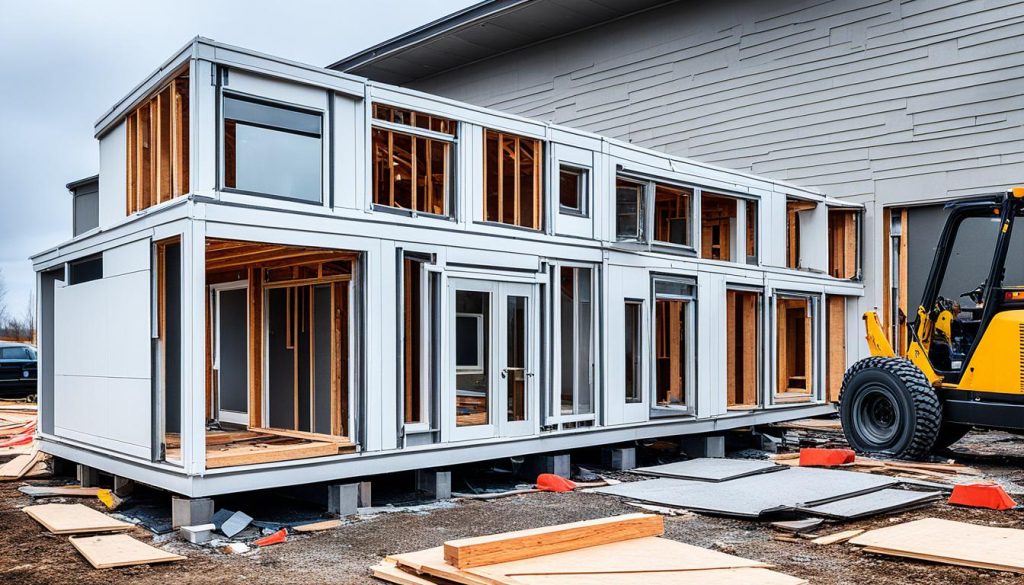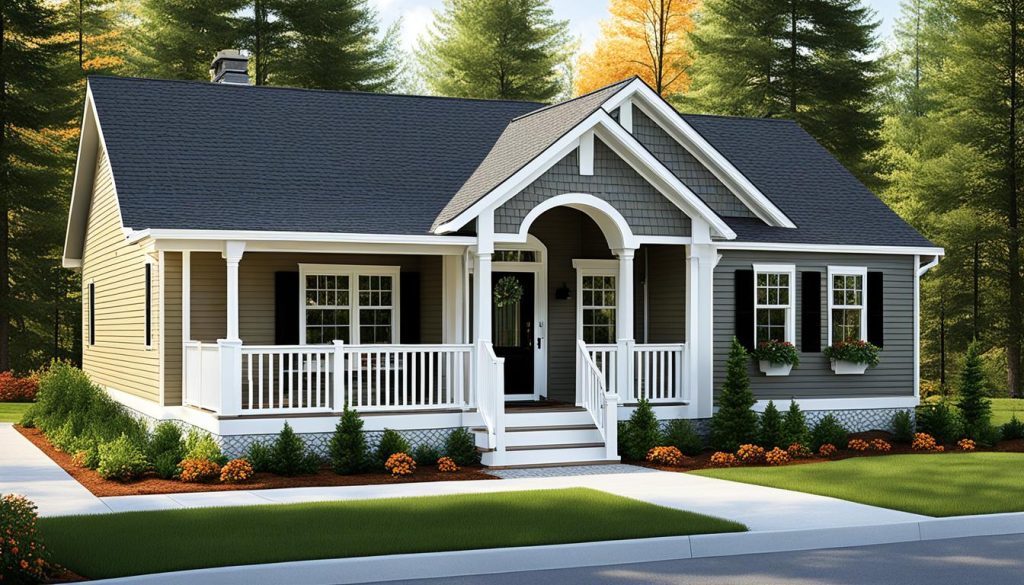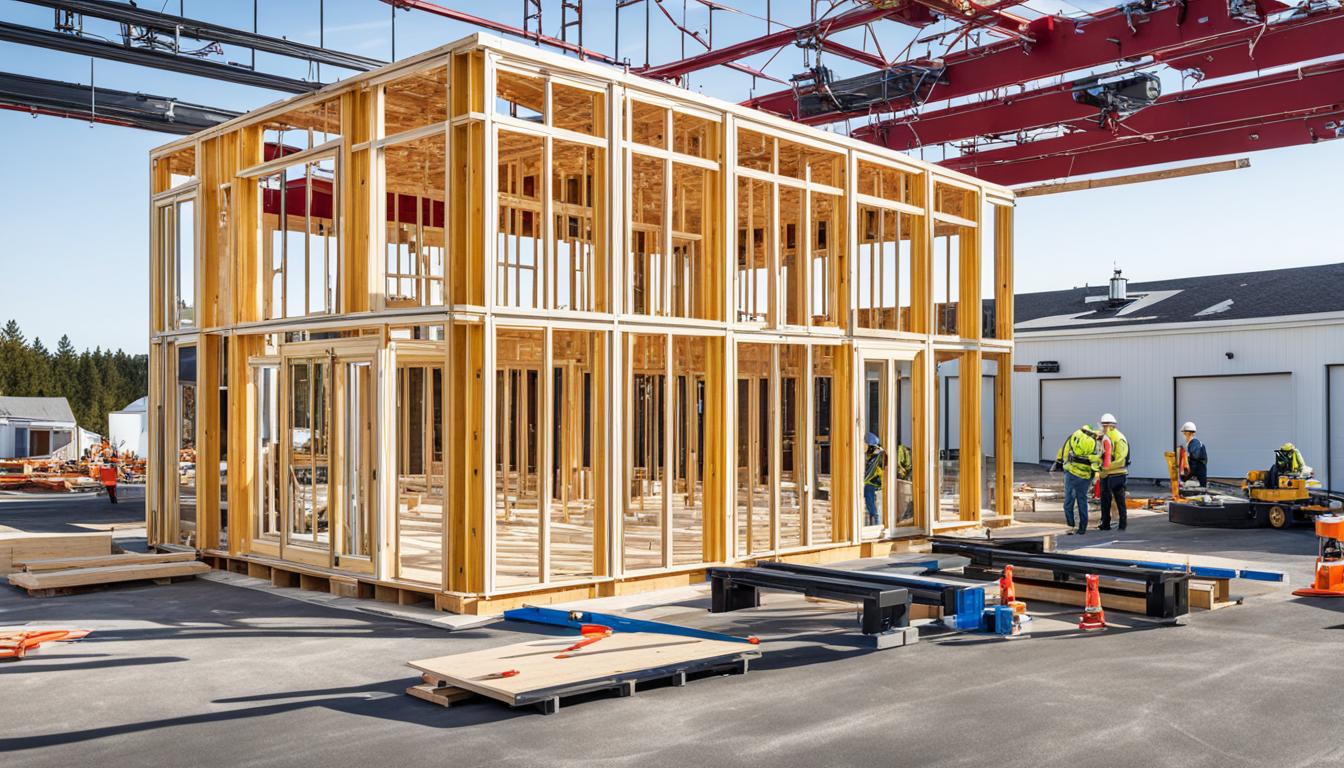Did you know that modular homes are gaining popularity as a competitive alternative to traditional onsite construction? These homes are built in sections in a factory and then assembled on-site. This off-site construction method offers numerous benefits, such as efficiency, adaptability, excellent resale value, and energy efficiency. However, there are also some drawbacks to consider, such as the need to find suitable land and limited design options. In this article, we will explore the pros and cons of modular homes, allowing you to make an informed decision about whether this construction method is right for you.
Key Takeaways:
- Modular homes are built in a factory and then assembled on-site.
- Advantages of modular homes include efficiency, adaptability, excellent resale value, and energy efficiency.
- Drawbacks of modular homes include the need to find suitable land and limited design options.
- Comparing modular homes to traditional homes reveals differences in cost, construction process, and customization options.
- When financing a modular home, construction loans are typically required, and it’s important to research financing options and consult with real estate agents.
Advantages of Modular Homes
Modular homes offer several advantages that make them an appealing choice for homeowners. Let’s explore some of the key benefits of modular construction.
Efficiency and Streamlined Process
Modular homes are built in a controlled factory environment with full project management, resulting in a quick and streamlined construction process. The factory setting allows for efficient construction, with skilled workers and quality control measures in place. Since the modules are prefabricated, this reduces the time required for on-site assembly.
Minimized Disruption to the Site
One major advantage of modular homes is that their construction is done off-site in a factory. This significantly minimizes disruption to the site where the home will be located. Unlike traditional on-site construction, there is less noise, mess, and hassle during the building process. This is particularly advantageous for homeowners seeking a more peaceful and organized construction experience.
Adaptability and Customization
Modular homes are highly adaptable, offering the ability to easily add rooms or change layouts. The modular construction process allows for flexibility in design, making it easier to accommodate specific needs and preferences. Whether you want to expand your living space or modify the floor plan, modular homes provide the flexibility to do so.
Reduced Delays
Weather conditions can often cause delays in traditional construction projects. However, modular homes are built indoors in a factory, unaffected by weather conditions that could otherwise impede progress. This results in fewer delays and ensures a more predictable construction timeline.
Excellent Resale Value
In the past, the resale value of modular homes may have been a concern. However, with advancements in modular construction, these homes now meet stringent quality standards and are virtually indistinguishable from onsite-built homes. This has significantly improved their resale value, giving homeowners peace of mind when it comes to their investment.
Energy Efficiency
Modular homes are designed to comply with building codes and energy efficiency standards. With proper insulation and construction techniques, these homes offer excellent energy efficiency. This translates into lower energy bills for homeowners, enhancing affordability and sustainability.
Simplified Compliance Process
When building a modular home, the compliance process is simpler compared to traditional construction. Since the plans for modular homes are predetermined and standardized, there is a reduced risk of unexpected complications during the building process. This leads to smoother compliance with building regulations, saving time and potential headaches.
| Advantages of Modular Homes |
|---|
| Efficiency and Streamlined Process |
| Minimized Disruption to the Site |
| Adaptability and Customization |
| Reduced Delays |
| Excellent Resale Value |
| Energy Efficiency |
| Simplified Compliance Process |
Disadvantages of Modular Homes
While modular homes come with numerous advantages, it’s important to consider the potential drawbacks before making a decision. Here are some disadvantages of modular houses:
- Limited Design Options: Unlike traditional homes that can be fully customized, modular homes have design limitations due to transportation regulations. The sections need to meet load requirements, which can restrict architectural flexibility.
- Requirement for Suitable Land: Building a modular home requires finding suitable land, which can vary depending on the buyer’s financial situation. This can pose a challenge, especially in high-demand areas or when specific zoning regulations need to be met.
- Additional Groundwork: Installing a modular home involves additional groundwork, including preparing the foundation and utility connections. This requires separate arrangements and can increase the overall construction cost.
- Potential Financing Challenges: Financing a modular home may be a challenge for first-time buyers. Some banks may not offer mortgages for prefab homes, making it more difficult to secure suitable financing options.
- Perception and Marketability: There can be a bias against modular homes due to confusion with manufactured or mobile homes. This misconception can impact the perceived value and marketability of modular homes.
To better understand the disadvantages of modular houses, it’s essential to weigh them against the advantages and consider individual preferences and circumstances.

Modular Homes vs. Traditional Homes
When it comes to choosing between modular and traditional homes, there are significant differences to consider. While traditional stick-built homes may be more familiar, they often come with higher costs and longer construction times due to weather delays and transportation issues. On the other hand, modular homes provide a more cost-effective, efficient, and stress-free option.
One of the main advantages of modular homes is the speed of construction. With most of the work completed in a factory setting, the assembly process on-site is much quicker, resulting in minimal disruption to the homeowner. This is especially beneficial for those who are on a tight timeline or want to avoid the inconveniences often associated with traditional construction.
Modular homes also fall under the broader category of prefab homes, but they differ in that they are built in multiple sections. This makes them highly adaptable and customizable compared to other types of prefabs. Whether you want to add rooms, change layouts, or personalize your home, modular construction offers greater flexibility and design options.
Furthermore, modular homes provide excellent quality assurance. The controlled factory environment allows for better quality control and consistency. Each module goes through rigorous inspections, ensuring that the final product meets or exceeds industry standards. With advancements in technology and manufacturing processes, modular homes are now virtually indistinguishable from their stick-built counterparts in terms of quality and appearance.

When it comes to cost, modular homes often offer significant savings compared to traditional construction methods. The streamlined factory production process reduces waste, and the bulk purchasing of materials results in lower costs. Additionally, modular construction is known for its energy efficiency, which can translate into long-term savings on utility bills.
In summary, modular homes provide a compelling alternative to traditional stick-built homes. They offer faster construction, greater adaptability, and cost-effectiveness while maintaining high-quality standards. Consider the benefits and advantages of modular homes when making your next housing decision.
What Are Modular Homes?
Modular homes are houses that are constructed in sections in a factory and then delivered to the site for assembly. These homes are not to be confused with manufactured or mobile homes, as they are built to the same standards as traditional homes and are considered permanent structures.
The individual modules of a modular home are transported on trucks and permanently fixed to the foundation. Before any additional site work, such as decking and landscaping, is completed, the modules are connected to site utilities. This off-site construction method allows for efficient and streamlined assembly, minimizing disruption to the construction site.
Modular homes offer a certain level of flexibility and customization. While they may have limited design options compared to traditional houses, they still provide a range of floor plans and finishes to suit different preferences and needs.
| Advantages | Disadvantages |
|---|---|
| Efficient and streamlined construction process | Limited design options compared to traditional homes |
| Minimal disruption to the construction site | Additional groundwork required |
| Flexibility in adding rooms or changing layouts | Challenges in financing for first-time buyers |
| Fewer construction delays due to weather conditions | Need to find suitable land for construction |
| Excellent resale value | |
| Energy-efficient with lower energy bills | |
| Simple compliance process | |
| Cost-effective compared to traditional homes |
How Are Modular Homes Constructed?
Modular homes are constructed in a factory environment, allowing for better quality control and faster assembly. The modular home construction process involves the following steps:
- Construction of Separate Modules: The construction begins with building separate modules in the factory. These modules include the flooring, wall, and roof systems.
- Erection of Walls: Once the modules are completed, the walls are erected to form the shell of the house. This provides the structural framework for the home.
- Transportation to the Building Site: The modules are then transported to the building site. They are carefully loaded onto trucks and delivered to their final location.
- Connection and Assembly: On-site, the modules are connected to create a cohesive structure. The connections are carefully secured to ensure stability and durability.
This controlled construction environment ensures consistent quality throughout the process. By building the modules simultaneously, it allows for quicker assembly on-site. With the majority of the construction done in the factory, the on-site work can be completed concurrently, saving time and reducing the risk of weather-related delays. This streamlined construction process is one of the key advantages of modular home construction.
Modular Home Construction Process Infographic
| Step | Description |
|---|---|
| 1 | Construction of Separate Modules |
| 2 | Erection of Walls |
| 3 | Transportation to the Building Site |
| 4 | Connection and Assembly |
Financing and Finding Modular Homes
When it comes to financing a modular home, the process may differ from traditional home financing. Since modular homes involve construction from the ground up, it is common to require construction loans for this type of project. However, some modular home companies offer their own financing options with more favorable terms, which can be worth exploring.
If you are looking for modular homes for sale, there are several avenues to explore. Major real estate websites often list modular homes, and there are also specialized sites dedicated to this type of home. As you search for your perfect modular home, consider factors such as style, location, customizability, and timeline. Additionally, it is essential to research the reputation of the manufacturer to ensure quality and reliability.
Consulting with local real estate agents can be invaluable in understanding the market perception of modular homes in your area. They can provide insight into financing options and help you navigate the process of buying a modular home with confidence. With the right knowledge and guidance, finding and financing your dream modular home can become a reality.

Leave a Reply
You must be logged in to post a comment.